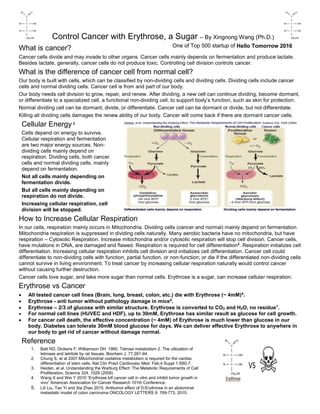
Control Cancer with Erythrose, a Sugar
- 1. Control Cancer with Erythrose, a Sugar – By Xingnong Wang (Ph.D.) What is cancer? One of Top 500 startup of Hello Tomorrow 2016 Cancer cells divide and may invade to other organs. Cancer cells mainly depends on fermentation and produce lactate. Besides lactate, generally, cancer cells do not produce toxic. Controlling cell division controls cancer. What is the difference of cancer cell from normal cell? Our body is built with cells, which can be classified by non-dividing cells and dividing cells. Dividing cells include cancer cells and normal dividing cells. Cancer cell is from and part of our body. Our body needs cell division to grow, repair, and renew. After dividing, a new cell can continue dividing, become dormant, or differentiate to a specialized cell, a functional non-dividing cell, to support body’s function, such as skin for protection. Normal dividing cell can be dormant, divide, or differentiate. Cancer cell can be dormant or divide, but not differentiate. Killing all dividing cells damages the renew ability of our body. Cancer will come back if there are dormant cancer cells. Cellular Energy 3 Cells depend on energy to survive. Cellular respiration and fermentation are two major energy sources. Non- dividing cells mainly depend on respiration. Dividing cells, both cancer cells and normal dividing cells, mainly depend on fermentation. Not all cells mainly depending on fermentation divide. But all cells mainly depending on respiration do not divide. Increasing cellular respiration, cell division will be stopped. How to Increase Cellular Respiration In our cells, respiration mainly occurs in Mitochondria. Dividing cells (cancer and normal) mainly depend on fermentation. Mitochondria respiration is suppressed in dividing cells naturally. Many aerobic bacteria have no mitochondria, but have respiration – Cytosolic Respiration. Increase mitochondria and/or cytosolic respiration will stop cell division. Cancer cells, have mutations in DNA, are damaged and flawed. Respiration is required for cell differentiation2 . Respiration initializes cell differentiation. Increasing cellular respiration inhibits cell division and initializes cell differentiation. Cancer cell could differentiate to non-dividing cells with function, partial function, or non-function; or die if the differentiated non-dividing cells cannot survive in living environment. To treat cancer by increasing cellular respiration naturally would control cancer without causing further destruction. Cancer cells love sugar, and take more sugar than normal cells. Erythrose is a sugar, can increase cellular respiration. Erythrose vs Cancer All tested cancer cell lines (Brain, lung, breast, colon, etc.) die with Erythrose (~ 4mM)4 . Erythrose - anti tumor without pathology damage in mice5 . Erythrose – 2/3 of glucose with similar structure. Erythrose is converted to CO2 and H2O, no residue1 . For normal cell lines (HUVEC and HDF), up to 30mM, Erythrose has similar result as glucose for cell growth. For cancer cell death, the effective concentration (~ 4mM) of Erythrose is much lower than glucose in our body. Diabetes can tolerate 30mM blood glucose for days. We can deliver effective Erythrose to anywhere in our body to get rid of cancer without damage normal. Reference 1. Batt RD, Dickens F, Williamson DH. 1960. Tetrose metabolism 2. The utilization of tetroses and tetritols by rat tissues. Biochem J. 77:281-94. 2. Chung S, et al 2007.Mitochondrial oxidative metabolism is required for the cardiac differentiation of stem cells. Nat Clin Pract Cardiovasc Med. Feb;4 Suppl 1:S60-7. 3. Heiden, et al. Understanding the Warburg Effect: The Metabolic Requirements of Cell Proliferation. Science 324, 1029 (2009) 4. Wang X and Wei Y 2010 “Erythrose kill cancer cell in vitro and inhibit tumor growth in vivo” American Association for Cancer Research 101th Conference. 5. Lili Liu, Tao Yi and Xia Zhao 2015. Antitumor effect of D-Erythrose in an abdominal metastatic model of colon carcinoma ONCOLOGY LETTERS 9: 769-773, 2015.